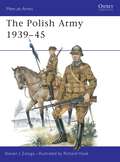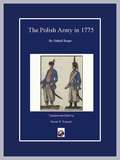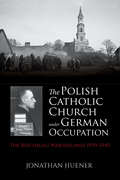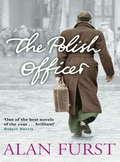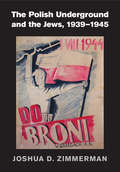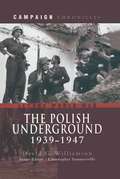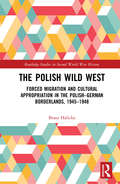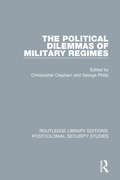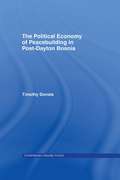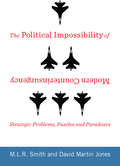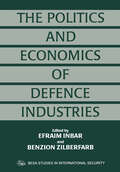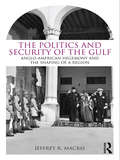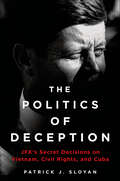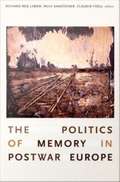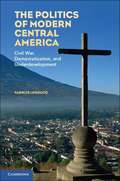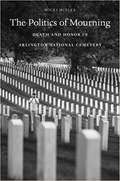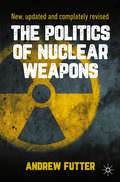- Table View
- List View
The Polish Army 1939-45
by Steven Zaloga Richard HookPoland was the first of the Allied nations to succumb to German aggression in the Second World War, but by the most tortuous of routes her army managed to remain in the field through all five years of bloody fighting. Polish soldiers fought in nearly every major campaign in the European theatre, and their tale is a complicated and tragic one. This richly detailed text by Steven Zaloga relates the story of the Polish Army during the Second World War, from the first wave of Stukas in 1939 to its eventual conclusion.
The Polish Army in 1775
by Vincent Rospond Gabriel Nichols RaspeGabriel Raspe's portraits of the Polish Army in 1775 is one of the earliest and complete representations of the Polish Army in the eighteenth century. For almost two hundred years this complete work has not been readily available, but Winged Hussar has edited this translation of the publication making it available to students and enthusiasts
The Polish Catholic Church under German Occupation: The Reichsgau Wartheland, 1939-1945
by Jonathan HuenerWhen Nazi Germany invaded Poland in 1939, it aimed to destroy Polish national consciousness. As a symbol of Polish national identity and the religious faith of approximately two-thirds of Poland's population, the Roman Catholic Church was an obvious target of the Nazi regime's policies of ethnic, racial, and cultural Germanization. Jonathan Huener reveals in The Polish Catholic Church under German Occupation that the persecution of the church was most severe in the Reichsgau Wartheland, a region of Poland annexed to Nazi Germany. Here Catholics witnessed the execution of priests, the incarceration of hundreds of clergymen and nuns in prisons and concentration camps, the closure of churches, the destruction and confiscation of church property, and countless restrictions on public expression of the Catholic faith. Huener also illustrates how some among the Nazi elite viewed this area as a testing ground for anti-church policies to be launched in the Reich after the successful completion of the war. Based on largely untapped sources from state and church archives, punctuated by vivid archival photographs, and marked by nuance and balance, The Polish Catholic Church under German Occupation exposes both the brutalities and the limitations of Nazi church policy. The first English-language investigation of German policy toward the Catholic Church in occupied Poland, this compelling story also offers insight into the varied ways in which Catholics—from Pope Pius XII, to members of the Polish episcopate, to the Polish laity at the parish level—responded to the Nazi regime's repressive measures.
The Polish Officer
by Alan FurstFrom the master of the historical spy thriller, a story set in the heart of the Polish resistanceSeptember, 1939. The invading Germans blaze a trail of destruction across Poland. France and Britain declare war, but do nothing to help. And a Polish resistance movement takes shape under the shadow of occupation, enlisting those willing to risk death in the struggle for their nation's survival. Among them is Captain Alexander de Milja, an officer in the Polish military intelligence service, a cartographer who now must learn a dangerous new role: spymaster in the anti-Nazi underground. Beginning with a daring operation to smuggle the Polish National Gold Reserve to the government in exile, he slips into the shadowy and treacherous front lines of espionage; he moves through Europe, changing identities and staying one step ahead of capture. In Warsaw, he engineers a subversive campaign to strengthen the people's will to resist. In Paris, he poses as a Russian poet, then as a Slovakian coal merchant, drinking champagne in black-market bistros with Nazis while uncovering information about German battle plans. And a love affair with a woman of the French Resistance leads him to make the greatest decision of his life.
The Polish Underground and the Jews, 1939–1945
by Joshua D. ZimmermanThe Polish Underground and the Jews, 1939–1945 examines one of the central problems in the history of Polish-Jewish relations: the attitude and the behavior of the Polish Underground - the resistance organization loyal to the Polish government-in-exile - toward the Jews during World War II. Using a variety of archival documents, testimonies, and memoirs, Zimmerman offers a careful, dispassionate narrative, arguing that the reaction of the Polish Underground to the catastrophe that befell European Jewry was immensely varied, ranging from aggressive aid to acts of murder. By analyzing the military, civilian, and political wings of the Polish Underground and offering portraits of the organization's main leaders, this book is the first full-length scholarly monograph in any language to provide a thorough examination of the Polish Underground's attitude and behavior towards the Jews during the entire period of World War II.
The Polish Underground, 1939–1947 (Campaign Chronicles)
by David G. WilliamsonThis study of the Polish resistance movement chronicles the operations of various factions from WWII through the postwar battle for power. The Polish partisan army famously fought with tenacity against the Wehrmacht during World War II. Yet the wider story of the Polish underground movement, which opposed both the Nazi and Soviet occupying powers, has rarely been told. In this concise and authoritative study, historian David Williamson presents a major reassessment of the actions, impact and legacy of Polish resistance. The Polish resistance movement sprang up after the German invasion of 1939. As the war progressed, it took many forms, including propaganda, spying, assassination, disruption, sabotage and guerrilla warfare. Many groups were involved, including isolated partisan bands, the Jewish resistance, and the Home Army which confronted the Germans in the disastrous Warsaw Uprising of 1944. Going beyond the Second World War, Williamson's graphic account chronicles the clandestine civil war between the Communists and former members of the Home Army that continued until the Communist regime took power in 1947.
The Polish Wild West: Forced Migration and Cultural Appropriation in the Polish-German Borderlands, 1945-1948 (Routledge Studies in Second World War History)
by Beata HalickaThe incorporation of German territories east of the Oder and Western Neisse rivers into Poland in 1945 was linked with the difficult process of an almost total exchange of population and involved the taking over of a region in which the Second World War had effected an enormous level of destruction. The contemporary term ‘Polish Wild West’ not only alluded to the reigning atmosphere of chaos and ‘survival of the fittest’ in the Polish–German borderland but was also associated with a new kind of freedom and the opportunity to start everything anew. The arrival in this region of Polish settlers from different parts of Poland led to Poles, Germans and Soviet soldiers temporarily coming into contact with one another. Living together in this war-damaged space was far from easy. On the basis of ego-documents, the author recreates the beginnings of the shaping of this new society, one affected by a repressive political system, internal conflicts and human tragedy. In distancing oneself from the until-recently dominant narratives concerning expellees in Germany or pioneers of the ‘Recovered Territories’ in Poland, Beata Halicka tells the story of the disintegration of a previous cultural landscape and the establishment of one which was new, in a colourful and vivid manner and encompassing different points of view.
The Political Dilemmas of Military Regimes
by Christopher Clapham and George PhilipFirst published in 1985, The Political Dilemmas of Military Regimes was written against the backdrop of the increased prominence of military intervention in the political process during this century. The book puts forward the argument that the basic problem for military regimes is not how they gain power, but what they can do with it once they have it. It discusses the enormous range of cultural and historical circumstances that military organisations are derived from, and how widely they vary in their structure, politics, and social composition. The book also highlights the dilemma of choosing between institutionalisation and demilitarisation as one that all military regimes must eventually face. The Political Dilemmas of Military Regimes is an in-depth study that draws on global material and experiences from throughout the century.
The Political Economy of China's Economic Zones
by George T. CraneIn 1979 China launched a new international economic policy with the establishment of four Special Economic Zones (SEZs): Shenzhen, Zhuhai, and Shantou in Guangdong Province and Xiamen in Fujian Province. Modelled loosely on export processing zones and free trade zones found in other less developed countries, the SEZs offer a variety of financial inducements to foreign investors in order to harness international business for national economic advantage. Designed to be a cornerstone of China's economic reforms, by 1985 the SEZs (in the mid-80s zone-like policies were extended to fourteen coastal cities) were scandal-ridden and fraught with serious problems. This work, the first book-length analysis in English of China's SEZs, examines the problems and promise of this innovative approach to "structural economic reform" and the comparative significance of the SEZs.
The Political Economy of Conflict in South Asia
by Matthew J. Webb Albert WijeweeraDestructive conflicts have thwarted growth and development in South Asia for more than half a century. This collection of multi-disciplinary essays examines the economic causes and consequences of military conflict in South Asia from a variety of perspectives embracing fiscal, social, strategic, environmental and several other dimensions.
The Political Economy of European Security
by Kaija SchildeWhat is the relationship between private actors and international institutions in global governance, as institutions such as the EU develop aspects of political authority once in the sole domain of nation states? Important areas of recent EU development have been immigration, security, and defense policies. Are these EU policies the result of strategic imperatives, or are they also driven by the political economy of markets? Kaija Schilde argues that answers require evaluating the EU in the comparative tradition of the political development of authority. Drawing on industry documents, interviews, interest group data, an original survey, and comparative political theory, The Political Economy of European Security demonstrates that interest groups can change the outcomes of developing political institutions because they provide sources of external capacity, which in turn can produce authority over time. In this way, the EU is like a developing state in its relationship with interest groups.
The Political Economy of Peacebuilding in Post-Dayton Bosnia (Contemporary Security Studies)
by Timothy DonaisA fresh examination of the political economy of the peacebuilding process in Bosnia-Herzegovina in the aftermath of the country's 1992-95 war. Little progress has been made in transforming the country's war-shattered economy into a functioning market economy, this new study explains the principal dynamics that have led to this, and places Bosnia's economic transition process within the context of the country's broader post-conflict peacebuilding process. The central argument this book persuasively advances is that much of Bosnia's ongoing economic crisis, and its current reform stalemate, can be explained by exploring the interactions of an inappropriate international model of economic reform with the country's particular post-conflict and post-socialist political economy. This book is essential for readers who wish to build an understanding of the region and assess its future prospects and hopes.
The Political Impossibility of Modern Counterinsurgency: Strategic Problems, Puzzles, and Paradoxes (Columbia Studies in Terrorism and Irregular Warfare)
by David Jones M.L.R. SmithThe counterinsurgency (COIN) paradigm dominates military and political conduct in contemporary Western strategic thought. It assumes future wars will unfold as "low intensity" conflicts within rather than between states, requiring specialized military training and techniques. COIN is understood as a logical, effective, and democratically palatable method for confronting insurgency—a discrete set of practices that, through the actions of knowledgeable soldiers and under the guidance of an expert elite, creates lasting results.Through an extensive investigation into COIN's theories, methods, and outcomes, this book undermines enduring claims about COIN's success while revealing its hidden meanings and effects. Interrogating the relationship between counterinsurgency and war, the authors question the supposed uniqueness of COIN's attributes and try to resolve the puzzle of its intellectual identity. Is COIN a strategy, a doctrine, a theory, a military practice, or something else? Their analysis ultimately exposes a critical paradox within COIN: while it ignores the vital political dimensions of war, it is nevertheless the product of a misplaced ideological faith in modernization.
The Political Road to War with Iraq: Bush, 9/11 and the Drive to Overthrow Saddam (Contemporary Security Studies)
by Paul Rogers Nick RitchieThis volume explores in close detail the events and factors leading up to the second Gulf War in 2003 and considers whether war with Iraq was inevitable. Nick Ritchie and Paul Rogers argue that after the election of George W. Bush, conflict between Iraq and the United States was probable, and that after 9/11 it became virtually inevitable. They begin by setting the story of Iraq, Bush and 9/11 within the broader context of the importance of the Persian Gulf to enduring US national security interests and go on to examine the intense politicking that surrounded the conflict and still reverberates today. The authors examine US policy towards Iraq at the end of the Clinton administration, the opposition in Congress and Washington’s conservative think tanks to Clinton’s strategy of containment, and the evolution of Iraq policy during the first eight months of the Bush presidency and the growing pressure for regime change. They also explore the immediate focus on Iraq after the attacks of September 11 that marked a watershed in US national security policy and chart the construction of the case against Iraq through 2002 and the administration’s determination to end Saddam Hussein’s regime at all costs. The Political Road to War with Iraq will be of great interest to all students and scholars of US foreign policy, war and peace studies and international relations.
The Politico-Military Dynamics of European Crisis Response Operations
by Alexander MattelaerHow do Europeans engage in military strategy? Through detailed comparisons of operational planning and exploring the framework of the EU, NATO and the UN, this book sheds light on the instrumental nature of military force, the health of civil-military relations in Europe and the difficulty of making effective strategy in a multinational environment
The Politics and Economics of Defence Industries
by Efraim Inbar Benzion ZilberfarbThis volume provides a policy-relevant analysis of the complex web of contemporary economic trends, political developments and strategic considerations that are shaping the contours of the new post-Cold War world market for weaponry.
The Politics and Security of the Gulf: Anglo-American Hegemony and the Shaping of a Region
by Jeffrey R. MacrisSince the 19th century the Gulf region has been an area of intense interest, having been influenced first by the British and more recently by the Americans. This book charts the changing security and political priorities of these two powers and how they have shaped the region. Adopting a narrative approach, the author provides background history on British involvement from the 19th century and a detailed analysis of the years after the Second World War, when oil supply became more critical. He covers the growth of US influence and the British withdrawal, and follows more recent changes as the US built up its military presence following Desert Storm and the invasion of Iraq. Looking at the three enduring missions fulfilled by the British - maintaining interstate order, protecting the free flow of commerce, which later included petroleum; and keeping out other Great Powers – the book demonstrates how these had by 1991 been assumed almost entirely by the American leaders. A comprehensive and thorough look at the history of the Gulf and the contemporary issues affecting the region, this will be essential reading for students of Middle East history, military history and diplomatic history.Visit the author's website at www.thepoliticsandsecurityofthegulf.com
The Politics and Strategy of Clandestine War: Special Operations Executive, 1940-1946 (Studies in Intelligence)
by Neville WylieThis fascinating new collection of essays on Britain’s Special Operations Executive (SOE) explores the ‘non-military’ aspects of British special operations in the Second World War. It details how SOE was established in the summer of 1940 to ‘set Europe ablaze’, as Churchill memorably put it. This was a task it was meant to achieve by detonating popular resistance against Axis rule, and nurturing ‘secret armies’, which might be capable of providing military and other forms of assistance for British forces when they were once again able to return to the offensive and conduct land operations in Europe. The importance of the collection, however, goes beyond merely illuminating aspects of SOE’s work which have largely been overlooked in previous scholarship. More significantly, by situating SOE within the context of Britain’s broader political needs, the essays demonstrate the extent to which SOE came to epitomise and embody the range of skills that are found in today’s secret service organisations. SOE showed itself capable of operating on a global scale and developing the necessary expertise, equipment and personnel to conduct activities across the whole spectrum of what we have come to know as ‘covert operations’. By bringing SOE’s activities into sharper focus and exposing the scale of its involvement in Britain’s wartime external relations, the essays echo current thinking on the place of the so-called ‘secret world’ in international politics.
The Politics of Deception: JFK's Secret Decisions on Vietnam, Civil Rights, and Cuba
by Patrick J. SloyanInvestigative reporter Patrick J. Sloyan, a former member of the White House Press Corps, revisits the last years of John F. Kennedy's presidency, his fateful involvement with Diem's assassination, the Cuban Missile Crisis and the Civil Rights Movement. Using recently released White House tape recordings and interviews with key inside players, The Politics of Deception reveals:Kennedy's secret behind-the-scenes deals to resolve the Cuban Missile Crisis.The overthrow and assassination of President Diem.Kennedy's hostile interactions with and attempts to undermine Martin Luther King, Jr. Kennedy's secret and fascinating dealings with Diem, General Curtis LeMay, King and Fidel Castro. Kennedy's last year in office, and his preparation for the election that never was.The Politics of Deception is a fresh and revealing look at an iconic president and the way he attempted to manage public opinion and forge his legacy, sure to appeal to both history buffs and those who were alive during his presidency.
The Politics of Industrial Collaboration during World War II
by Talbot Imlay Martin HornDid Ford SAF sabotage the German war effort by deliberately manufacturing fewer vehicles than they could have? Ford SAF claimed after the war that they did. Exploring the nature and limits of industrial collaboration in occupied France, Horn and Imlay trace the wartime activities of Ford Motor Company's French affiliate. The company began making trucks and engine parts for the French military; but from 1940 until Liberation in 1944 was supplying the Wehrmacht. This book offers a fascinating account of how the company negotiated the conflicting demands of the French, German and American authorities to thrive during the war. It sheds important new light on broader issues such as the wartime relationship between private enterprise and state authority; Nazi Germany's economic policies and the nature of the German occupation of France, collaboration and resistance in Vichy France, and the role of American companies in Occupied Europe.
The Politics of Memory in Postwar Europe
by Richard Ned Lebow Wulf Kansteiner Claudio FoguFor sixty years, different groups in Europe have put forth interpretations of World War II and their respective countries' roles in it consistent with their own political and psychological needs. The conflict over the past has played out in diverse arenas, including film, memoirs, court cases, and textbooks. It has had profound implications for democratization and relations between neighboring countries. This collection provides a comparative case study of how memories of World War II have been constructed and revised in seven European nations: France, Germany, Austria, Switzerland, Poland, Italy, and the USSR (Russia). The contributors include scholars of history, literature, political science, psychology, and sociology. Country by country, they bring to the fore the specifics of each nation's postwar memories in essays commissioned especially for this volume. The use of similar analytical categories facilitates comparisons. An extensive introduction contains reflections on the significance of Europeans' memories of World War II and a conclusion provides an analysis of the implications of the contributors' findings for memory studies. These two pieces tease out some of the findings common to all seven countries: for instance, in each nation, the decade and a half between the late 1960s and the mid-1980s was the period of most profound change in the politics of memory. At the same time, the contributors demonstrate that Europeans understand World War II primarily through national frames of reference, which are surprisingly varied. Memories of the war have important ramifications for the democratization of Central and Eastern Europe and the consolidation of the European Union. This volume clarifies how those memories are formed and institutionalized. Contributors. Claudio Fogu, Richard J. Golsan, Wulf Kansteiner, Richard Ned Lebow, Regula Ludi, Annamaria Orla-Bukowska, Heidemarie Uhl, Thomas C. Wolfe
The Politics of Military Coalitions
by Scott WolfordMilitary coalitions are ubiquitous. The United States builds them regularly, yet they are associated with the largest, most destructive, and consequential wars in history. When do states build them, and what partners do they choose? Are coalitions a recipe for war, or can they facilitate peace? Finally, when do coalitions affect the expansion of conflict beyond its original participants? The Politics of Military Coalitions introduces newly collected data designed to answer these very questions, showing that coalitions - expensive to build but attractive from a military standpoint - are very often more (if sometimes less) than the sum of their parts, at times encouraging war while discouraging it at others, at times touching off wider wars while at others keeping their targets isolated. The combination of new data, new formal theories, and new quantitative analysis will be of interest to scholars, students, and policymakers alike
The Politics of Modern Central America
by Fabrice Lehoucq"This book analyzes the origins and consequences of civil war in Central America. Fabrice Lehoucq explains why the inability of autocracies to reform led to the civil wars of the 1980s and why violent conflict led to the unexpected transition to non-military governments in the 1990s. He examines why economic stagnation throughout much of the region, along with unevenness of political reform, has limited democratization. This book also uses these developments to shed light on core debates in comparative politics, suggesting that more progress has been made in understanding the persistence of inequality than in identifying the causes of civil war"--
The Politics of Mourning
by Micki McelyaArlington National Cemetery is America's most sacred shrine, a destination for four million visitors who each year tour its grounds and honor those buried there. For many, Arlington's symbolic importance places it beyond politics. Yet as Micki McElya shows, no site in the United States plays a more political role in shaping national identity.
The Politics of Nuclear Weapons: New, updated and completely revised
by Andrew FutterThis comprehensively updated second edition provides an introduction to the political, normative, technological and strategic aspects of nuclear weaponry. It offers an accessible overview of the concept of nuclear weapons, outlines how thinking about these weapons has developed and considers how nuclear threats can continue to be managed in the future. This book will help you to understand what nuclear weapons are, the science behind their creation and operation, why states build them in the first place, and whether it will be possible for the world to banish these weapons entirely. Essential reading for all students of International Relations, Security Studies and Military History.
